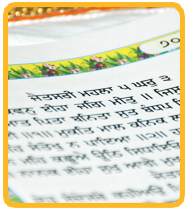At times, there is mention of Ghar in various headings in Sri Guru Granth Sahib and then there are various other headings wherein there is no mention of Ghar. Therefore, it is intriguing whether Ghar is related only to those banis, sabads and chhants on which Ghar has been mentioned, or Ghar is applicable to those sabads/chhants also, that follow.
The study of concept of Ghar in Gurbani has revealed that after first mention of Ghar at SGGS 14 of Sri Guru Granth Sahib, all sabads, saloks, savayiye, chhants are in one or the other Ghar. But this fact needs to be established.
In an endeavor to explore any references, the puratan pothis i.e. copies of portions of or complete Adi Granth, hand written by the writers of Guru’s time, and thereafter, were studied. The focus of this study was to find headings of Ghar on those sabads or chhants on which there is no mention of Ghar in Sri Guru Granth Sahib.
A few, of the puratan pothis that have been referred to, have been mentioned here under;
Description of old hand-written Granths with their approximate time period.
| Approximate Time Period | Name of Puratan Granth/Pothi |
| 1650 | Gurdwara Sahib Dhobri Sahib, Assam |
| 1650 | Gurdwara Bal Leela, Patna Sahib |
| 1654 | Bura Sandhu Wali Bir, Sri Amritsar |
| 1661 | Kangari, Patiala |
| 1663 | Tikana Bhai Ram Kishan Sheran Wala Gate, Patiala |
| 1692 | Guru Granth Sahib Adheyan Vibhagh Library Punjabi Univ. Acc. No 115988 |
The writers of such manuscripts, might have pursued different approaches. One most expected approach is that writer would write, as is where is, from the compilation/Granth from where one is copying. This, in fact, is the most prevalent approach of most hand-written manuscripts.
The other approach would be to endeavor to incorporate the information about the sabads that is prevalent in their times in spite of the fact that such mention may not be the part of the original Pothi/Puratan Granth whose copy was being generated. It was the latter approach that was being sought while searching various puratan hand written copies of Adi Granth of old times.
A few rare copies of the latter approach could be found wherein Ghar has been duly mentioned, at places, where there is no corresponding mention of Ghar on corresponding sabads in Sri Guru Granth Sahib.
The observations in such hand written manuscripts reveal that in contrast to mention of Ghar only on the first sabad, at the start of a new Ghar; there is continued mention of Ghar in the heading of following sabads, after its first mention at the start of new Ghar, in puratan pothis. Further, it was observed that there is also mention of Ghar on certain sabads in old manuscripts (puratan pothis), where there is no corresponding mention of Ghar, at all, on sabads in Sri Guru Granth Sahib.
From the revelation of Ghar, in hand-written old manuscripts, at places where there is no corresponding mention in Sri Guru Granth Sahib, we can infer that, at the times of Guru Sahib, the awareness of Ghar would have been a common knowledge among contemplators of Gurbani. This, also, seems one of the reason for indicative mention of Ghar in certain headings and not on every heading in Sri Guru Granth Sahib.
Among such hand written manuscripts, viz. the hand written compilation of Gurdwara Dhobri Sahib, Assam and that of Gurdwara Bal Leela, Patna Sahib have endeavored to preserve the common knowledge of Ghar in their literary compilation, therefore, such manuscripts are significant for understanding awareness of Ghar , among Gursikhs, in older times.

At SGGS 359 of Sri Guru Granth Sahib, there is a sabad “ਮਨੁ ਮੋਤੀ ਜੇ ਗਹਣਾ ਹੋਵੇ” This sabad is in Ghar 6. And there also is a heading over this sabad wherein Ghar 6 is duly mentioned. After this sabad, there is another sabad “ਕੀਤਾ ਹੋਵੈ ਕਰੇ ਕਰਾਇਆ” at SGGS 359, followed by sabad ਗੁਰ ਕਾ ਸਬਦ ਮਨੈ ਮਹਿ (SGGS 359); ਗੁੜ ਕਰਿ ਗਿਆਨੁ (SGGS 360) and “ਖੁਰਾਸਾਨ ਖਸਮਾਨਾ ਕੀਆ” (SGGS 360). While there is no mention of Ghar 6 in the sabads that follow viz. “ਮਨੁ ਮੋਤੀ ਜੇ ਗਹਣਾ ਹੋਵੇ” in Sri Guru Granth Sahib, however, Ghar 6 is mentioned in the headings of all of these sabads that follow “ਮਨੁ ਮੋਤੀ ਜੇ ਗਹਣਾ ਹੋਵੇ” in hand-written compilation of Gurdwara Bal Lela, Patna Sahib.
Although it has been indicated by old manuscripts that sabads, in Sri Guru Granth Sahib, that are without mention of Ghar in their heading are also in accordance with the concept of Ghar. However, this issue can be settled only if we get a plausible explanation from within Sri Guru Granth Sahib. Let us, therefore, take up certain references right from Sri Guru Granth Sahib to settle this issue.
In Sri Guru Granth Sahib, there are four highly significant references that establish that those sabads whose Ghar is not determined by prior mention of Ghar in their heading are also in some Ghar. These references are as under;
- ਏਕ ਸੁਆਨ ਕੈ ਘਰਿ ਗਾਵਣਾ (SGGS 91) i.e. sing this sabad in the Ghar of sabad “ਏਕ ਸੁਆਨ”
- ਪਹਰਿਆ ਕੈ ਘਰਿ ਗਾਵਣਾ (SGGS 93) i.e. sing this sabad in the Ghar of sabad “ਪਹਰੇ”
- ਰਹੋਏ ਕੇ ਛੰਤ ਕੇ ਘਰਿ (SGGS 203) i.e. sing this sabad in the Ghar of Chhant of “ਰਹੋਏ”
- ਯਾਨੜੀਏ ਕੈ ਘਰਿ ਗਾਵਣਾ (SGGS 802) i.e. sing this sabad in the Ghar of sabad “ਯਾਨੜੀਏ”
From these highly significant directives from Sri Guru Granth Sahib (discussed in detail, separately), we can derive important inference in relation to the issue under reference viz. all those sabads/chhants on which there is no mention of a Ghar, are also in some or the other Ghar. This, thus, settles the issue that Ghar is applicable to entire Gurbani of Sri Guru Granth Sahib whether or not Ghar is mentioned in the title.
Further, close examination of headings of Ghar in Sri Guru Granth Sahib reveals that Ghar 1 has largely been discussed at the outset in Sri Guru Granth Sahib from SGGS 14 to SGGS 22, thereafter, from SGGS 26 to SGGS 50, from SGGS 52 to SGGS 70 and thereafter from SGGS 93 to SGGS 203.
After extensively discussing Ghar 1, Ghar 2 is discussed extensively from SGGS 203 to SGGS 243, from SGGS 348 to SGGS 357 and then from SGGS 360 to SGGS 364.
After such extensive elaboration of Ghar 1 and Ghar 2, these two types of Ghar are not always mentioned in Sri Guru Granth Sahib whereas all other types of Ghar are duly mentioned whenever any sabad is in any Ghar other Ghar 1 and Ghar 2.
The concept of Ghar is equally applicable on Bhagat bani enshrined in Sri Guru Granth Sahib. Some examples of Bhagat Bani include ਸ੍ਰੀ ਕਬੀਰ ਜੀਉ ਕਾ ਚਉਪਦਾ ਘਰੁ 2 ਦੂਜਾ (SGGS 524); ਗੂਜਰੀ ਸ੍ਰੀ ਨਾਮਦੇਵ ਜੀ ਕੇ ਪਦੇ ਘਰੁ 1 (SGGS 524); ਗੂਜਰੀ ਸ੍ਰੀ ਰਵਿਦਾਸ ਜੀ ਕੇ ਪਦੇ ਘਰੁ ੩ (SGGS 525); ਗੂਜਰੀ ਸ੍ਰੀ ਤ੍ਰਿਲੋਚਨ ਜੀਉ ਕੇ ਪਦੇ ਘਰੁ 1 (SGGS 525) and ਗੂਜਰੀ ਸ੍ਰੀ ਜੈਦੇਵ ਜੀਉ ਕਾ ਪਦਾ ਘਰੁ 4 (SGGS 526).
The concept of Ghar in Bhagat Bani is similar to the concept of Ghar in entire Sri Guru Granth Sahib. This fact gets duly emphasized at SGGS 93 of Sri Guru Granth Sahib wherein a sabad of Bhagat Beni ji is being asked to be sung in accordance with the Ghar of Pehre by Guru Nanak Sahib ji. The heading of the sabad is “ਸ੍ਰੀ ਰਾਗ ਬਾਣੀ ਭਗਤ ਬੇਣੀ ਜੀਉ ਕੀ ਪਹਰਿਆ ਕੈ ਘਰਿ ਗਾਵਣਾ”
The common knowledge of Ghar, in the times of Gurus, could be another reason leading to non-mention of Ghar upon every sabad /chhant of Sri Guru Granth Sahib.
Thus, it can be resolved that once Ghar is mentioned in Sri Guru Granth Sahib, at SGGS 14, Ghar applies to the entire Gurbani of Sri Guru Granth Sahib.
And why Ghar is first mentioned only at SGGS 14 and not on SGGS 1 onwards is also discussed, separately.








